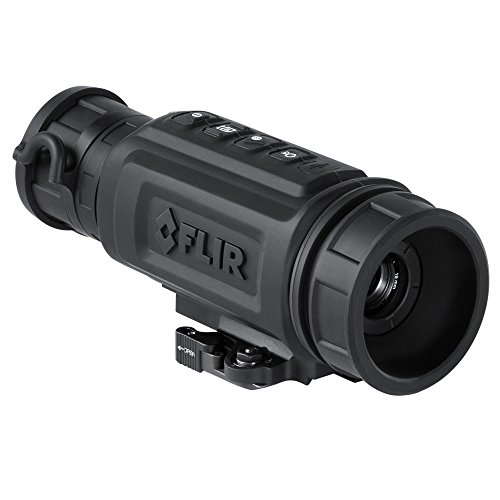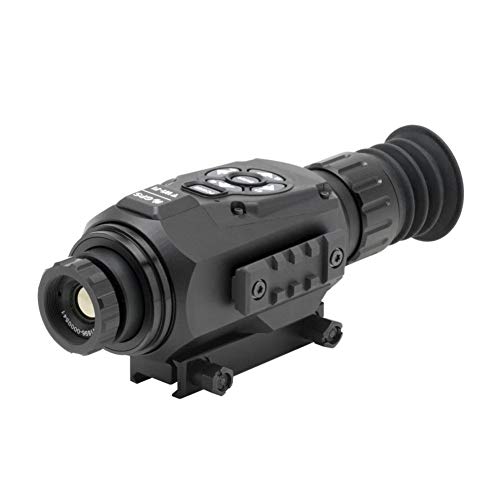This site contains affiliate links. As an Amazon Associate, I earn a commission from qualifying purchases at no extra cost to you. Full Disclosure Here.
Hunting furry critters and putting down bad guys is all good and fun for roughly 12 hours a day.
For the other time, after the sun goes down, those critters naturally have the upper hand. They have learned to use their natural night vision and the cover of darkness to evade predators, search for food, and avoid high daytime temperatures.
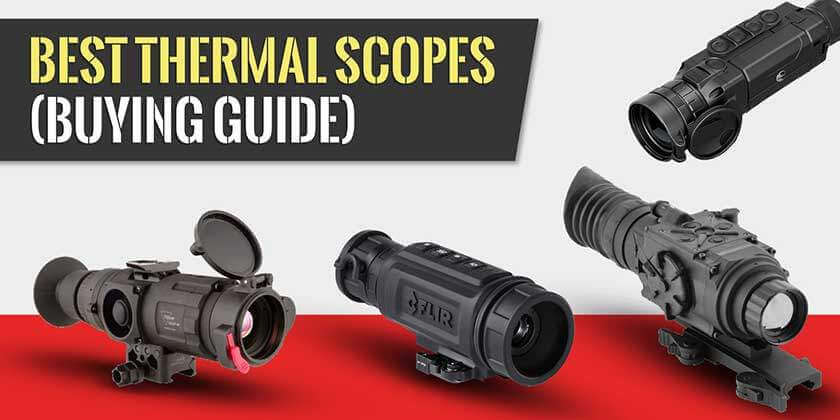
At A Glance: Our Top 5 Picks For Thermal Scopes in 2024
- Editor's Choice: Trijicon REAP-IR Series
- Best for Hunters: Trijicon IR-Hunter MK3
- Best for Magnification: N-Vision Optics Halo-LR
- Best Resolution: Pulsar Thermion XP50
- Best Budget: Armasight by FLIR Predator 336
Luckily for you, whether you’re putting food on the table or liberating a foreign country in turmoil, there is a modern tool that can basically turn you into the terminator and keep you plinking 24 hours a day, light or dark.
I remember the first time I got to use a thermal scope. It was a PAS-13 thermal weapon sight passed to me by my platoon commander. Looking through the scope, I couldn’t believe how easy it was to pick out the steel targets which were still hot from the high daytime temperatures of the Mojave desert.
I was pretty excited, thinking that someday I might get issued one, but then he told me the optic costs around 40 grand. Looking down at my PVS-14 night vision that was held together with duct tape, I was reminded that the Marine Corps is broke and realized I was never going to be issued one.
The good news is thermal scope prices have dropped a lot. Don’t get me wrong they’re still pretty expensive, but when shopping for thermals you have to utilize the “buy once cry once” mentality.
You can find videos of thermal optics in action all over YouTube. They’re commonly used in southern states like Texas by hunters attempting to solve “The Plague of the Pigs” where invasive hog species are wreaking havoc and causing millions of dollars in damage annually.
Many states have lifted all hunting restrictions so you can kill as many as you want, whenever you want, with whatever you want. If hunters can’t solve the hog problem, southern states may have to resort to poisoning the pigs’ food supply, which could have serious environmental consequences.
So, if you do decide to pick up a thermal scope head down and help our friends in the south solve their pest problem!
| IMAGE | PRODUCT | |
|---|---|---|
Editor's Choice | Trijicon REAP-IR Series
| VIEW ON AMAZON →VIEW ON OPTICS PLANET → |
Best for Hunters  | Trijicon IR-Hunter MK3
| VIEW ON AMAZON →VIEW ON OPTICS PLANET → |
Best for Magnification 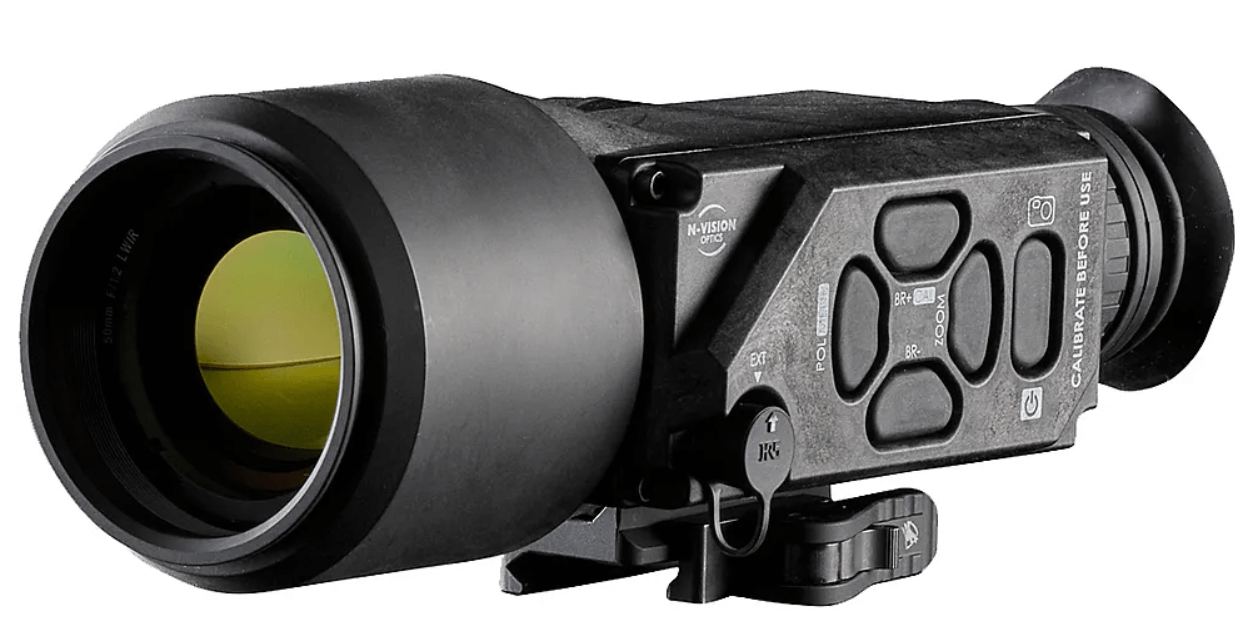 | N-Vision Optics Halo-LR
| VIEW ON AMAZON →VIEW ON OPTICS PLANET → |
Best Resolution 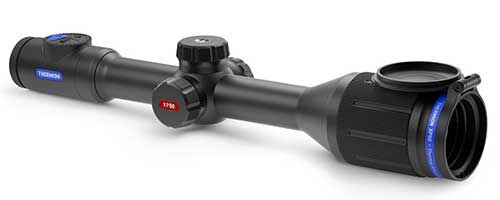 | Pulsar Thermion XP50
| VIEW ON AMAZON →VIEW ON OPTICS PLANET → |
Best Budget  | Armasight by FLIR Predator 336
| VIEW ON AMAZON →VIEW ON OPTICS PLANET → |
Nowadays you can find thermals all over Amazon and even in some chain sporting goods stores.
With prices being low and availability being high, it may sound quite simple to purchase a new fancy thermal scope, however, there are many different styles and many different variations to choose from. Without first understanding the science of thermal scopes and the lingo this new breed of tech comes with, choosing the best thermal scope for your intended use may be challenging.
This guide will help you understand how thermal imaging works, the different types of thermal imaging, identifying the type of thermal unit you need and will help guide you through the process of purchasing one so you can get on with bullet slinging all night long!
Here Are the Best Thermal Scopes
1. Trijicon REAP-IR Series – Marine Approved Choice Award
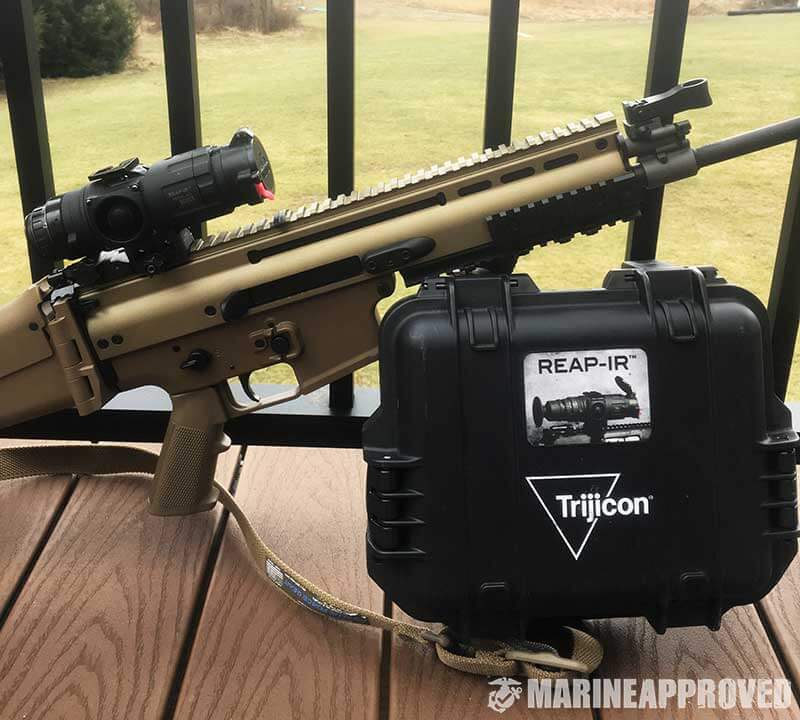
NV Tech Generation: Gen 3
Resolution: 640×480 12 Micron core
Refresh Rate: Variable 30-60hz
Magnification: 2.5-20x35mm
Detection Range: 450 Yards
Rangefinder: Stadiametric
Recording: Requires recording accessories
Battery: 2 CR123 but usable with rechargeable batteries or external battery packs
Water Resistance: IPX7
My Review: The Trijicon Reap-IR is undoubtedly the most famous and well-known thermal scope in the game and rightfully so as it was a total shock to the market when it came out. The release of the Trijicon Reap-IR made everything else at the time obsolete and raised the bar especially when it comes to sensor quality, durability, and resolution. The Reap-IR has spent several years at the top of the podium for thermal scopes and has been utilized in combat countless times.
One of the primary things that make the Reap-IR so valuable is that it integrated much higher industry-leading resolution that took thermal scopes from grainy nasty looking imaging to rather quite cleaned up and crisp sight pictures. They’ve done this by leaving the old 17 Micron chips behind and opted for 12 Micron chips instead.
Related Article: 15 Best Long Range Rifles (Ranked by a Marine Sniper)
The Reap-IR made target acquisition in low-light conditions almost better than what it would be like trying to acquire targets in the daylight and this quickly became a favorite tool to use of soldiers in combat, special forces, hog hunters, and firearm enthusiasts. Of course, this extensive fame is partially why the price is so high but there really aren’t any other phenomenal competitors with market-ready devices launching at the moment so I suppose the price makes sense.
Another major feature that was introduced first on the Reap-IR was it’s digitally enhanced focus. There is no dial to turn for focus, instead, you use the on-board technology to adjust the focus digitally.
The Reap-IR is by far the toughest and more durable thermal scope on the market. The Reap-IR is rated at IPX7 water resistance, meaning it can survive 1-meter dips while most other thermal scopes are only IPX6 or less. The overall build quality is exceptional with what feels like a more solidly built 6061 Aircraft-grade aluminum enclosure for the electronics and optics and, of course, you can constantly protect the optical lens with the eyecup addition.
Found on the Trijicon Reap-IR are several different objective lens options to choose from. The 35mm version seems to be right in the middle of what most of the line up offers. Something else to note here is that the front lens on the scope is a Germanium lens and is extremely expensive. This type of lens allows for the high-resolution collection of infrared radiation which is what allows the scopes onboard computer chip more information to create that high-quality sight picture with such fast refresh rates.
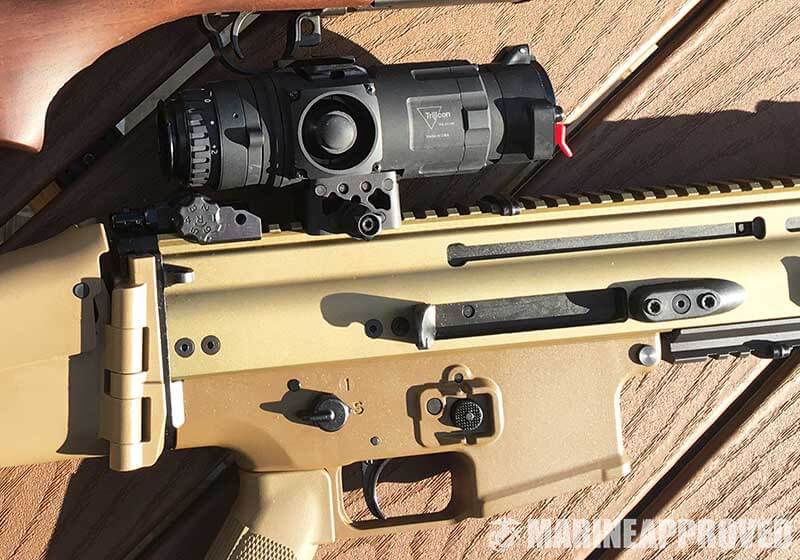
The eye-cup you can get with these is really interesting and most people haven’t seen anything like this before. Of course, the glass and internals of the Trijicon are its weak spots and they’ve figured out a way to minimize exposure to the rear of the sight by using a rubber “wall” that collapses only when you press your face up to it. This means the back of the sight is walled off from the elements so it’s not getting rained on, dust, scratched, etc. It’s kind of weird to get used to and I think most people shooting at the range or for fun would ditch it but if you’re in combat or hunting in harsh elements, it might just be the difference between coming home happy and coming home with a damaged $7,000-$9000 optic.
Before choosing your Reap-IR it’s important to note that there are multiple versions that are easily identifiable by the size of the objective lens. The larger the objective lens, the more light and better the sight picture but the more expensive and heavier the optic will be. It’s important to keep in mind that the Reap-IR comes in several different flavors with these flavors vary with respect to the objective lens size and both base and digital zoom capabilities. There are a few other differences between the Type 1 and Type 2 Reap-IR scopes.
Stats available for the Reap-IR version 1:
35mm objective lens with 2.5x base magnification and 20x digital zoom.
Stats available for the Reap-IR version 2:
20mm objective lens with 1.5x base magnification and 12x Digital zoom.
35mm objective lens with 2.5x base magnification and 20x Digital zoom.
60mm objective lens with 4.5x base magnification and 36x Digital zoom.
Here is a video showing this scope being used for hunting.
Key Features:
- 35mm compact, lightweight 640×480 thermal sensor
- Digital contrast enhancement (DCE) and digital focus control (DFC)
- Stadiametric ranging
- Edge detection mode.
- Reticle position readouts with multiple reticles save locations and five reticle patterns.
- Thumbstick system controller.
- 12-micron technology sensor.
- Uncooled Vox frame rate with a refresh rate of 60 Hz.
- Digital OLED with e-zoom.
- Polarity start-up time: 5 sec.
2. Trijicon IR-Hunter MK3
Resolution: 640×480
Refresh Rate: 30-60 FPS
Magnification: 4.5-36x60mm
Detection Range: 500 Yards
Rangefinder: Stadiametric
Recording: With add-ons
Battery: ~5 hours with 2 CR123
Water Resistance: IPX7
My Review: While the Trijicon Reap-IR is a bit more on the battle-hardened side, the MK3 IR-Hunter is a lot more focused on hunters and outdoorsman. The IR-Hunter is still IPX7 water-resistant and constructed out of high-quality Aircraft-grade 6061 aluminum but has a design style that’s a bit less like a protective fortress and instead went with a more streamlined approach.
Yes, you can still get the fancy eyecup that only exposes the rear lens when pressing up against it!
The IR-Hunter comes along with a lot of new features you won’t find on the IR-Reap. One of the key features that are new here is the Enhanced Target Recognition (ETR) image enhancing tool that adjusts the portion of the image being rendered to focus on where the target would be while dialing back detail on areas of the sight picture that aren’t of interest and thus avoiding washout from sources of light.
Most thermal scopes feel like a shooter’s aid in terms of operation in low light setting and target acquisition but using the Reap-IR or IR-Hunter feels more like cheating. You can see everything with a heartbeat at ridiculous distances, probably further than a lot of people could even shoot accurately at. This is definitely the best hog hunting thermal scope on the market today.
Related Article: 17 Best Long Range Rifle Calibers (Ranked by a Marine Sniper)
At $9000, this is the most expensive scope that we have on our list, but the features included are worth it if you have this type of money to spend on a badass thermal scope. Trijicon is known to be expensive but it’s also among the most battle-hardened brands out there.
Check out the video below as it has some awesome footage!
Cons:
- May see divorce summons when your spouse sees the receipt
Key Features:
- Enhanced target recognition
- Digital contrast enhancement
- 8x digital zoom 12-micron technology
- Multiple reticle options
- Turret knobs for superior ergonomics
- Full digital video
- Polarity start-up time: 5 sec
- Includes 7 batteries with a battery life of 6 hours
- Quick detach weapon mount
3. N-Vision Optics Halo-LR

Resolution: 640×480
Refresh Rate: 60 FPS
Magnification: 1x, 2x, or 4x Digital Zoom
Detection Range: 2000 Yards
Rangefinder: N/A
Recording: N/A
Battery: Four CR123
Water Resistance: IPX6
My Review: The N-Vision Optics Halo-LR is a newer thermal scope to the market and is by far one of the best for the money.
First and foremost, the N-Vision Halo-LR is using a 60hz refresh rate, which is immediately noticeable compared to other lower refresh rates found in cheaper consumer-grade thermal optics. The higher refresh rate means your sight picture is being refreshed 60 times per second, giving you a huge advantage over something that has maybe 30hz. High refresh rate thermal optics are insanely hard to manufacture but it seems like technology is catching up and the future of thermal optics is looking not only bright but super crispy and clear!
Popular Article: 21 Best Red Dot Sights (Ranked by a Marine)
N-Vision has achieved such a great refresh rate inside of an overall fantastic optical package by using a 12-micrometer thermal chip, which is currently the smallest possible chip at the time of reviewing this product. This chip is significantly smaller and also outputs less heat, allowing the manufacturer to cram more technology in a smaller and lighter space.
Another huge advantage of having better computing power onboard is being able to push better display technology. With higher resolution and frame rates the magnification can be pushed further without losing tangible detail, thus giving you a much further range of target detection. Sure, a lot of thermal scopes can “detect” thermal images for “thousands” of yards, but only a few like the Halo-LR can actually show you enough detail to identify the target properly and ensure a safe and professional shot is taken.
Key Features:
- Equipped with a beautiful class-leading OLED display
- A maximum thermal detection range of 2020 yards with a variable zoom of 1x, 2x, and 4x
- Pre-loaded with 6 different thermal optimized reticles
- Fully waterproof and minimally impacted by heavy rain
- 50mm fully multi-coated germanium objective lens with anti-reflection
- Weighs less than 30oz, making this one of the most feature-rich thermal sights in this weight range
4. Pulsar Thermion XP50

Resolution: 640×480
Refresh Rate: 50 FPS
Magnification: 1.9-15.2x
Detection Range: 1900m
Rangefinder: Stadiametric
Recording: HD Video and Image capturing with recoil activation
Battery: Two Rechargeable Li-Ion 18650
Water Resistance: IP67
My Review: The Pulsar Thermion lineup is the successor to the Trail series and with that comes a new computer chip and some improved performance. Another 20 FPS with a pretty good bump in resolution creates an entirely new experience for the user and also gives the Thermion a massive boost in its effective range.
Basically, if you liked the Trail series but want to update to the most modern technology, the Thermion is what you need. It’s got highly efficient 18650 batteries that are rechargeable and the built-in recording is both higher quality and more efficient on power usage.
Related Article: 7 Best Night Vision Scopes (Ranked by a Marine)
Using the Thermion XP50 does feel like thermals are headed in the right direction. Pulsar is really a leader in some ways in this industry despite the Trijicon thermals being a bit better in quality and reputation. The Thermion encompasses some tech that its competitors brought forth first but also implemented some new details that I think others will follow up with.
50 fps sure does feel good and the current resolution is a huge step up from what we’ve had before so I think the next generation of thermal scopes are going to have to be especially efficient at dissipating heat in order to use more power chips to render better frames and resolutions.
5. Pulsar Helion XP Thermal Monocular
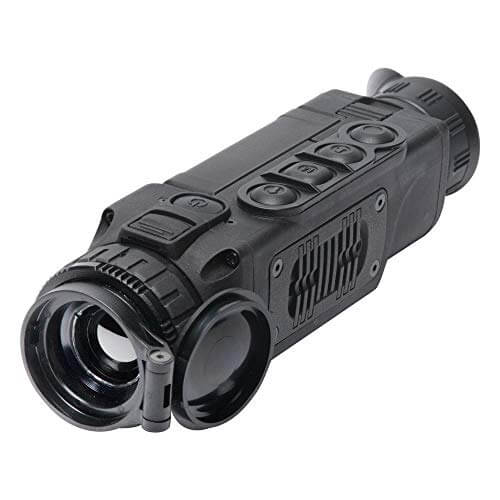
Resolution: 640×480
Refresh Rate: 50 FPS
Magnification: Varied by model
Detection Range: 1,000 to 2,000 yards depending on which model you get
Rangefinder: Stadiametric
Recording: HD Recording with live streaming capabilities
Battery: 8 hours with Li-Ion rechargeable battery pack
Water Resistance: IPX7
My Review: Before we get started I do want to mention that this is not a scope but a monocular. Sometimes when people ask me for a recommendation on getting a thermal scope it turns out that they would benefit more from having a monocular. So with that said, this is just something I recommend if perhaps you decide against getting a thermal scope.
This is perfect for those who wish to share their adventures on the web since its capable of HD live streaming via an internet connection! It is a great little thermal camera for recording video and taking photos when traveling, hunting, or exploring.
The thermal monocular comes with 8GB of onboard video storage and is damn near capable of going anywhere with IPX7 waterproofing, frost resistance, extreme temperature resistance, fog proofing, and impact resistance. This bad boy comes with just about every bell and whistle you can pack into a monocular and comes with an industry competitive 8-hour battery life.
The different models are as follows:
XP28 1.4-11.2x28mm
XP38 1.9-15.2x38mm
XP50 2.5-20.0x50mm
Key Features:
- Integrated accelerometer
- Onboard video recorder with 8GB internal storage
- Built-in wifi and Stream Vision app integration
- 8 custom color palettes
6. Pulsar Trail XQ/LRF XQ Series (Best Value Scope)
Resolution: 384×288
Refresh Rate: 30 FPS
Magnification: 10.8x42mm or 2.1-8.4x32mm on the LRF model
Detection Range: 1800m
Rangefinder: On LRF Model
Recording: HD Video and Sound
Battery: 8 hours with a Li-Ion Battery Pack
Water Resistance: IPX7
My Review: Pulsar is one of the leading thermal scope companies, which is why I have several of there scopes on this list. With that being said, this isn’t exactly what most people would consider the pride and joy from Pulsar, however, I think it fills a role that their other products don’t fully address.
The Trail XQ38 is rather similar to the XP50 as the two thermals are nearly identical on the outside, but they do have different lens sizes. The XQ38 has a 32mm lens with a wider field of view (16.3 degrees) with a base magnification of 1.2x. The XP50 has a 42mm lens with a field of view of 12.4 degrees and a base magnification of 1.6x.
Pulsar also makes a cheaper model (the XQ30). Of course, the smaller the objective lens, the less efficient it will be at creating a sight picture so I recommend going as large as what’s within your budget and weight constraints.
This scope has most all the features a good thermal scope should have. It’s not going to give you the kind of clarity from high resolution and high frame rate capability like a more expensive Trijicon thermal will but at this price point, this scope is a great value and is perfect for those of you who don’t need a combat-ready thermal. The Pulsar Trail XQ38 has an internal video recorder, rechargeable battery, built-in memory, and a whole lot more.
NOTE: This model was improved upon in the next generation, the Thermion lineup which we will also review in this guide. If you can get a good deal on the Trail series and it suites your needs then by all means, it’s still a good scope and I recommend grabbing it if it’s right for you.
Key Features:
- 50mm eye relief
- Multi-Functional Media Controller
- Mobile Connectivity with live streaming
7. Pulsar Trail XP50

My Review: This thermal scope from Trail is one of the best values per available features of any scope we have reviewed in the mid-range price section. At a price between 4 and $5000, its price tag sits right smack in the middle of the lowest and highest price ceilings for thermal scopes.
I have attached a video of a Trail XP50 being used for coyote hunting. If you hit the link below the scope there is also a good video on the Amazon product page that goes more in detail about the scope’s features.
Key Features:
- Ultra-easy operator interface; simple to use without any training.
- Come with an 8-hour rechargeable battery supply
- 50Hz refresh rate
- Integrated accelerometer
- Built-in stadiametric rangefinder
- Wide operating temperature range of -13° – 122°
- Heat detection up to 2,000 yards
- Onboard video recorder with an 8gb internal storage
- Built-in WiFi and Stream Vision App – “Observe, Stream, Transfer, Upgrade”
- IPX7 waterproof, dust-proof, fog-proof performance
8. Flir ThermoSight R-Series RS64 2-16X
Resolution: 640×480 VOx
Refresh Rate: 30 FPS
Magnification: 2-16x
Detection Range: 400 Yards
Rangefinder: N/A
Recording: Video Out Capable
Battery: Internal Rechargeable Li-Ion Offers Four Hours
Water Resistance: IPX7
My Review: FLIR is one of the oldest entities in the thermal market and has products ranging from thermal cameras that fit in the palm of your hand to thermal imaging sensors for aircraft scanners. FLIR is some of the most popular technology used by law enforcement and border security.
This FLIR thermal shooting scope comes with 3 reticle settings and has a heat signature detection range of 400 yards. The 640×480 Vox resolution means that you will experience some pretty industry-standard resolution at this price point and overall, it’s especially crisp for hunting. The scope has an impressive excess of 4 hours of battery life while in operation, not standby.
The FLIR Thermosight encompasses a lot of the same technology we’ve come to expect from scopes at higher price points such as the optimization of color palettes as well as video customization. At just over $5100, this scope is on the high-side of the medium range of thermal scopes but is an excellent all-around value for hunters and firearm enthusiasts. I put a video of the scope being used for hog hunting below.
Key Features:
- 640×480 Vox HD active-matrix LCD display
- Submersible up to three feet
- 3 reticle settings optimized on any color settings
- Clear thermal imaging up to 400 yards
- 60mm focal length lens
- 3” eye relief
- Advanced proprietary ThermoSight image correction system
- Simple 4 button operation design
- Six video palettes including FLIR InstAlert
9. ATN OTS-HD 640 Thermal Smart HD Monoculars
Resolution: 640×480
Refresh Rate: 50 FPS
Magnification: 1-10x or 1.5-15x options
Detection Range: 1000m
Rangefinder: Integrated Smart Rangefinder With Ballistic Calculator
Recording: HD Video and photo with recoil compensation features and live streaming via Wi-Fi
Battery: Integrated 20,000 mAh ATN Power Pack
Water Resistance: IP55
My Review: This offering from ATN is not meant for shooter optic applications, however, it is by far one of the most advanced thermal spotting systems on the market today. It is a monocular-type thermal imaging device that is perfect for home security and surveillance applications.
As mentioned before, these types of monocular devices do not include any reticle; and their included feature set makes this device perfect for shooting high-resolution thermographic videos. ATN pulled out all the stops on this one and implemented the most cutting edge technology to perfect their thermal imaging systems. I put a video below so you can see the image quality.
There is a cheaper version called the ATN OTS-HD 384 that is about $1800 at the time of writing. It’s got a smaller objective lens and is capable of less resolution at 384×288 with a 4.5-18x magnification.
Key Features:
- Wireless internet (Wi-Fi) capability with apps available for viewing on your Android or iPhone screens
- 3D gyroscope
- Geotagging capable
- Built-in laser rangefinder
- E-Compass and ballistic calculator
10. Armasight Apollo Pro 640 Thermal Clip-On
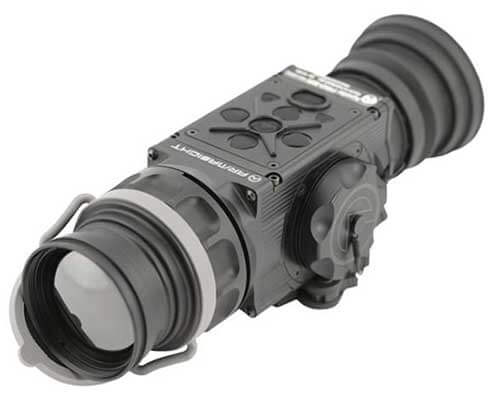
Resolution: 800×600
Refresh Rate: 30 FPS
Magnification: 2x, 4x, 8x Digital Zoom With Reticle Tracking
Detection Range: 800m
Rangefinder: N/A
Recording: Video Output
Battery: CR123
Water Resistance: IP67
My Review: This FLIR scope is designed to be mounted on a rifle in tandem with another set of optics. The idea of a clip-on is that you only bolt it onto your rifle when you need it and when you don’t you just pull it off and stash it away. The Clip-On thermal device will allow you to use your scope just as you would normally but with thermal vision capabilities.
The Apollo Pro includes a high-performance thermal imaging camera offering relatively great resolution at 640×512.
The scope out of the box is quite versatile as it will fit on any Picatinny MIL 1913 or Weaver rail. It has the option of adding an external power supply as well as a recording device capable of shooting some awesome thermal videos. Ranging in the mid-$3000’s, this scope is pretty affordable, especially because of its shooting capabilities and specifications. The manufacturer usually backs their products with a 3-year warranty (at least at the time this article was posted) so you can rest assured even when using this clip-on scope in the most extreme conditions.
Key Features:
- The latest Tau 2 17-micron uncooled FLIR core technology
- User-selectable options for White Hot/ Black Hot/ Rainbow/ and other Various Color Modes.
- 6 variable, digitally-controlled reticle patterns available:
- Reticle Colors: Black, White, Red, Cyan
- Electronic zoom reticle tracking capability maintaining boresight
- Used as a Clip-On in tandem with other optical solutions
- Integrated OLED SVGA Display
11. Armasight by FLIR Predator 336

Resolution: 336×256
Refresh Rate: 60 FPS
Magnification: 2-8x25mm
Detection Range: 600m
Rangefinder: N/A
Recording: HD Recording With Video Output and Onboard Replay
Battery: Two CR123 batteries or optional rechargeable battery pack
Water Resistance: IPX6
My Review: This Armasight FLIR Systems-manufactured thermal rifle site is a vision of beauty to behold. It is a feature-rich system (feature list to follow) device with the latest technologies. With 6 digital reticle settings and built-in MIL-STD-1913 rails, it comes ready to mount to your weapon of choice for operating in daylight or total darkness. For less than $2000, this is a more economical choice for shooters who don’t want to sacrifice too much quality but still want to pick up one of the best budget thermal imaging scopes on the market. I attached a video below of the Armasight predator below. Just a warning the video does show some hogs being killed.
Key Features:
- Latest Tau-2 17-micron FLIR core technologies
- Choice of 6 different reticle sights in 3 different colors
- Constructed with aircraft aluminum frame
- Germanium objective lens
- Image Palettes White Hot, Black Hot, Fusion, Rainbow, Globow, Ironbow 1, Ironbow 2, Sepia, Color 1, Color 2, Ice-Fire, Rain, and Custom
- Reticle Type 6-Pattern Digitally Controlled: “Dot 4 MOA”, “Line Dot”, “Cross Center Dot”, “Cross”, “Crosshair”, and “No Reticle”
- Eye Relief 45 mm
12. ATN ThOR 4 Scope (Best Cheap Thermal Scope)

Resolution: 384×288
Refresh Rate: 30-60 FPS
Magnification: 1.25-5x, 2-8x, 4.5-18x, or 7-28x options
Detection Range: Depends on the model. 500-1500m
Rangefinder: Integrated ABL Digital Rangefinder
Recording: HD Video and Live Streaming with RAV
Battery: ATN Li-Ion 20,000 mAh Rechargeable Battery for up to 22 hours of use
Water Resistance: IP55
My Review: This sub-$2000 reticle-enabled shooting optic FLIR scope from ATN has an ultra-sensitive and cutting-edge sensor, which, according to the manufacturer, is able to capture very sharp, crisp, and clear images even at the furthest range specifications with improved resolution, sensitivity, and color gradients, even in total darkness or other low-visibility situations.
The ATN Thor 4 includes an image stabilization system as well as a ballistic calculator that improves accuracy by calculating wind, range, optimal settings for multiple weapons, and all sorts of other useful settings. This is an all in one monster of a system and leaves nothing to be desired. Getting a Thor4 is easily one of the best cheap thermal scopes out there! Here are some cool videos showing the scope in action.
Here is another good video that coves the features of this scope.
Ballistic calculator system includes:
- Range
- Wind
- Temperature
- Angle of target
- Humidity
- Bullet ballistics
- Dual-stream video recording in HD resolution that records to the SD card as well as your mobile devices
- Recoil activated video
Key Features:
- Gen 4 sensor with 384×288 resolution at 60hz
- 1280×720 HD display
- Quick detach mount
- ATN ABL Laser range finder system
- Remote controller
13. ATN ThOR HD 384
Resolution: 384×288
Refresh Rate: 30-60 FPS
Magnification: 4.5-18x or 9-36x
Detection Range: Depends on the model.
Rangefinder: Integrated Smart Rangefinder
Recording: HD Video and live streaming
Battery: ATN 20,000 mAh integrated rechargeable battery pack
Water Resistance: IP55
My Review: This ATN Thor HD 384 Smart Rifle Scope has all of the features of the previous ATN monocular-type viewer-only scope. However, this model is a shooter optic with reticles, meant for rifle mounting. Just like the other ATN scope reviewed here, this rifle mounted thermal device is packed with features, including wireless internet (Wi-Fi) capability, 3D gyroscope, geotagging capable, and a built-in rangefinder, compass, zoom; as well as apps available for viewing on your Android or iPhone screens. I attached a video of the thermal being used for hunting below.
Key Features:
- Wireless internet (Wi-Fi) capability with live streaming and apps available for viewing on your Android or iPhone screens
- 1280×720 HD display
- 3D gyroscope
- Geotagging capable
- E-Compass
- E-Zoom system enabling the device to focus and auto-zoom on specific targets from 1.25-5x using Smooth Zoom
14. Sig Sauer Echo 3
Resolution: 320×240
Magnification: 1-6x or 2-12x Reflex Style Configurations
Refresh Rate: 30 FPS
Detection Range: 300m
Rangefinder: N/A
Recording: HD Video and imaging
Battery: Six hours on CR123
Water Resistance: IPX6
My Review: This is the newest version of the Sig Sauer Echo lineup and here we see a very advanced version of what they started with. While the very first edition of the Echo only had a 1-2x magnification range, the Echo 3 now has an expanded 1-6x digital zoom giving this reflex a huge boost in combat effectiveness equalling that of most battle sights.
The Echo 3 still lags behind most other new-generation thermal scopes in resolution but it doesn’t quite feel that way when you’re actually using it. The Echo 3 is really designed to be used at rather close distances on something like an entry-level hog hunt with a .223 platform. A lot of people give these flack for not being clear out for hundreds of yards and while they do have an impressive range for a reflex form factor, yeah, they aren’t that great but that’s because they weren’t designed to do that.
Something else that’s new to the Echo 3 that we didn’t get on the Echo 1 is the ability to record in HD and stream that over via WiFi or Bluetooth. This also includes a feature where footage is saved based on detected recoil so that even if you have to take a quick shot when you weren’t quite ready, you still get the footage.
It’s hard to explain what it’s like using a scope like this. It’s really the only one of its kind and it doesn’t really have any direct competitors. Yeah, it’s in the form factor of a reflex sight but what we’re looking at is a digitally enhanced stream of information on a screen. It feels like manufactured unlimited eye relief if that makes sense which isn’t a good or bad thing, it just feels odd for a little while.
This really is a cool idea and so far it seems like Sig has done a decent job of at least keeping up technology-wise with the thermal market as a whole. I’m pretty surprised no one else has really given this idea a solid go but hopefully, we see one soon as I do believe there is a future market for a small and compact reflex form factor thermal sight that is a lot more versatile, especially in CQB situations, than what we have now in the current thermal scopes market.
15. Sig Sauer Echo 1

Resolution: 206×156
Refresh Rate: 50hz
Magnification: 1-2x30mm
Detection Range: 300m
Rangefinder: N/A
Recording: Single Photo and Burst
Battery: Two CR123A
Water Resistance: IPX6
My review: Sig Sauer is a house-brand we all know and love for a multitude of great products from firearms to crystal clear optics and so on. If you mention just about anything firearm related I can immediately recommend a Sig Sauer product off the top of my head but if you were to mention thermal scopes, well, that would be a big miss for me. I actually didn’t know about this little gem until not so long ago and it quickly caught my eye as both unique and actually practical. I’m not sure I’ve gotten to experience a thermal red dot that I’d actually want to use until now!
For the money this isn’t a bad thermal but it is a little dated at this point so don’t expect a high-resolution image or cutting edge refresh rates. For most everything Sig Sauer, you’ll pay once and cry once but in this case, technology has outpaced what this scope was originally equipped with.
If you have the money and you’re looking for the highest-end technology encompassed inside the most durable constructed units, Sig Sauer is a strong go to brand and even though this unit is a bit older, it’s still a solid choice if you want to save some cash and don’t need recording or higher screen technologies.
This was really the first (to my knowledge) consumer-grade thermal reflex attempt and so far I’m actually quite impressed. The addition of unlimited eye relief is a breath of fresh air from what always feels like very cramped thermal scope eye relief. Having the option to digitally zoom in to 2x is a huge step in the right direction as that boosts the versatility of a reflex by a lot. I’m sure models in the future will likely expand magnification in similar use cases which might bring about some really cool optical configurations in the near future. I think that’s what this reflex is really all about, showing what’s possible and expanding our idea of what a thermal scope can be. Hopefully the Echo 1 stands as a token of what can be accomplished and what is ahead for optical technology.
Note: Since we last updated this page to include the Echo 1 it has been updated and we actually missed a generation! We’ll be adding the Echo 3 to this page so make sure to check that out!
Key Features:
- Uncooled Vox microbolometer array
- 5 default reticle options
- Ability to design and implement customized reticles
- Color matrix LCD display for both day and night
- White or black hot heat configurations plus customizable color palette
- Lensarmor for protection against scratches and abrasions
- Top-mounted peep sights
- SIG SAUER ROMEO1 adapter plate
- Designed and assembled in the USA
16. FLIR Systems Scout III-240 Thermal Imager
Note: Designed for Viewing Only
Resolution: 640×480
Refresh Rate: 30-60 FPS
Magnification: 1x, 2x, or 4x Digital Zoom
Detection Range: 1200 Yards
Rangefinder: N/A
Recording: N/A
Battery: Five-hour rechargeable Li-Ion
Water Resistance: IP67
My Review: This FLIR monocular is a step in quality from the Scout TK model reviewed earlier. This increase in price comes with a TON of advantages over the other; including the ability to see tiny heat signatures at a 1200 feet (400 yards) range. This is a field-tested monocular that is great for coyote and hot hunting. Just keep in mind this is a viewer only so you will need night vision scope or another thermal scope if you are planning on doing any night hunting. Also read our list of best night vision scopes for coyote hunting here.
It is relatively cheap when compared to the higher end models we will be reviewing in this guide, but includes specifications that make it perfect for visualizing thermal signature images in a pretty clear 640×480 resolution and super-fast 30 Hz – 60 Hz vertical refresh rate. It is one of the best thermal viewers available – with super-fast power-on options, compact size, and a whole slew of gradient choices, including black hot, white-hot, Gradedfire and InstAlert (a trademarked detection palette algorithm).
Key Features:
- Customizable color palettes
- Thermal imaging in all lighting conditions
- Pocket size design and weighs only 12oz
17. FLIR Scout TK Pocket-Sized Thermal Monocular

Note: Designed for Viewing Only
Resolution: 160×120
Refresh Rate: 9 FPS
Magnification: 1x
Detection Range: 100 Yards
Rangefinder: N/A
Recording: N/A
Battery: Rechargeable Li-Ion battery pack for about five hours
Water Resistance: IP67
My Review: Coming in around $500, this is the cheapest thermal optic on this list. It is a very affordable handheld monocular you can actually pick on Amazon. The TK is quite a formidable competitor in this market and allows for full water submersion with the implementation of IP 67 waterproofing.
If I were looking for a small pocket size thermal imaging system and didn’t want my bank account to cry, this is likely what I’d buy. Despite it being so small, you’ll still get a range of 100 yards and the camera couldn’t be easier to use. You can watch the video below to get an idea of what the image quality looks like. All in all, it’s a cheap thermal camera that is pretty good for viewing at short distances.
Key Features:
- 640×480 LCD display
- Compact pocket size design
- 20×16 field of view
- Comes with a neck lanyard, USB cable, and lens cap
- Only weighs 6oz
How to Choose a Thermal Scope (Buying Guide)
If you want to get up to speed on the basics of thermal scopes and thermal scope terminology, this section is for you.
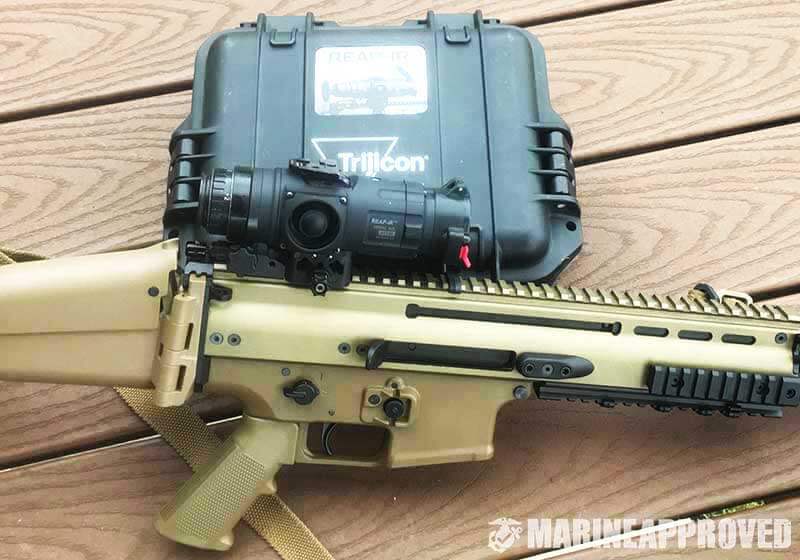
What is a Thermal Scope?
Thermal scopes fall into the field of infrared imaging technologies. The thermographic cameras that are built into thermal scopes use infrared technology to detect sources of radiation emitted from heat-producing sources.
This is made possible through the miracle of modern science, that is, scientists in this field learned that because all sources of heat with a temperature higher than absolute zero (a very, very cold temperature) emit a certain type of radiation within the infrared range on the color spectrum that is invisible to the naked eye; this radiation could be visualized on screen with or without illumination.
Thermal scopes utilize infrared radiation to produce an enhanced contrast image of what is viewed through the scope that allows the user to identify targets even in poor visibility.
Most scopes combine a small thermographic camera with an aiming reticle that allows the operator to quickly identify anything that gives off a heat signature.
The ability of thermal scopes to operate in complete darkness means the shooter can take the necessary time to place a well-aimed shot. For hunting, this means the takedown will be quick and a total surprise to the target or prey despite lighting conditions.
Night Vision vs Thermal Scopes – What is the Difference?
Here is a good video that provides an overview of how the two distinct technologies work. If you don’t want to watch the video, I have provided a summary below the video.
Night vision goggles (NVGs) work by detecting low levels of light and amplifying it. The distinct green color is used on purpose because the human eye is sensitive to green. You may notice some of the newer scopes use blue, but most still use green.
Night vision goggles allow the wearer to have enhanced visibility in dark conditions. They do require at least some ambient light to create a picture and cannot pick up on energy given off in the form of heat. This is a significant problem if using night vision on very dark nights or inside buildings when the lights are off.
Thermal scopes offer an entirely different experience and a much more enhanced visual capability in total darkness, even when there is no available light.
In these scenarios, thermal imaging scopes take advantage of the known scientific fact that all heat-producing bodies emit small amounts of infrared radiation, which is invisible to the naked eye and NV technologies.
The image produced by a thermal scope is less detailed than most types of NVGs, but objects are much easier to find through the scope and the forward-looking infrared (FLIR) technology that makes these thermal scopes possible is far more advanced than the technologies used in night vision.
How Do Thermal Scopes Work?
The images produced by thermal scopes are depicted in high contrast light between objects giving off energy and their less energized surroundings.
Remember, energy is heat and heat is what we’re targeting. If you’re shooting at targets that do not produce heat, thermal scopes will be nearly useless for you other than to show you what not to shoot at.
First and foremost, we need to understand what it is we are trying to see. Since our eyes cannot see most of the light in our world, we need to narrow down what we need to view.
In the case of Infrared light waves, there are three types.
Near-infrared is the closest to visible light.
Mid-infrared is what we use when we turn the TV on with a remote controller.
Thermal-infrared, which occupies the largest portion of the light spectrum is what we are looking for when implementing thermal scope technology. This type of infrared is emitted by an object instead of being reflected off of it like the other types of infrared above. This type of light is emitted due to the atomic release of energy.
To pick up thermal light that we cannot see, we must use special equipment with lenses that can focus on the thermal infrared light and then paint us a picture by rendering it with a processing unit.
There are typically 3 pieces to a thermal scope.
Optics: Are used to focus and sometimes magnify the target.
Infrared Detector: All energy gives off light, but the human eye can only pick up a very small portion of the light spectrum. The infrared detector focuses on energy in the air which is on a spectrum our eyeballs cannot see. Thermal light occupies the largest portion of the light spectrum, thus making the task of an infrared detector very difficult as nearly everything gives off at least some signature of energy.
Signal Processor: This is where the image is created by painting you a colorful picture the infrared detector is witnessing. Since you can’t see what the infrared detector can, the signal processing unit must translate the image into something viewing to the human eye.
There are two main types of thermal imaging.
Forward-looking infrared technology (FLIR; pronounced “Fleer,” like the baseball card company) is a specific type of thermographic IR technology type which is the IR technology used primarily in aircraft or satellite thermographic imaging.
Sideways tracking systems can only utilize a one-dimensional sweep of pixels, the digital dots which make up the resulting false-color IR image that is viewed by the operator.
How Are Thermal Scopes Used?
Thermal imaging has a lot of use cases.
Like I mentioned earlier, the most common civilian application is hunting, especially hog and coyote hunting.
Many farmers and hunters use thermal scopes to prevent hog overpopulation on their property, but because the pigs reproduce so rapidly their efforts have been futile, even with hunters killing them around the clock from helicopters and with state of the art shooting gear.
To see thermal rifle scopes in action just type in “Best thermal night hunting videos with the Trijicon REAP-IR” into YouTube. You can copy and paste the words between the quotation marks there into YouTube and the video I’m talking about should be the first one to pop up. Just a forewarning the video is pretty graphic.
Thermal imagers are also handy tools for search and rescue teams. This is demonstrated quite a bit on the television show “Alaska State Troopers” for search and rescue operations. Without thermal imaging locating lost hikers and party members in the extensive and vast open spaces of the Denali Wilderness Reserve would be nearly impossible.
Their usefulness is also demonstrated on the US Border Patrol focused television series “Border Wars”. On the show, they use thermal equipped Black Hawk helicopters to detect illegal border crossings and to direct ground agents to a group of suspects fleeing the area.
If you’ve ever seen this in action, you know how difficult it is, if not close to impossible, for a fleeing suspect to evade a thermographic tracking imaging device, whether it’s the FLIR module mounted to the Black Hawk of a FLIR-equipped thermographic scope being used in the same capacity while mounted to an agent’s assault rifle.
They’re commonly used by search and rescue teams, law enforcement, and military units. A few years ago, they were too expensive for the everyday outdoorsman, but the prices have dropped quite a bit enabling a price range friendlier for the general consumer.
You can pick up a high-quality thermal optic without having to worry about a lien being put on your house or shelling out your child’s entire college fund (only part of it needed)!
The technology has been used to successfully detect cancerous tumors, allergies in animals; in fact, the CDC even used thermographic imaging to scan for cases suspicious for swine flu during the 2009 scare involving that disease.
If you’ve walked through immigration at an international airport lately, you may have noticed a station set up with massive cameras. These cameras are thermal imaging cameras used to see if travelers are running unusually high fevers or carrying something abnormally full of energy with them.
11 Tips and Considerations When Buying a Scope
Do You Need a Handheld Thermal Monocular or Thermal Rifle Scope?
When considering how thermals will operate with your loadout, first you need to decide if a handheld device would suffice or you require a mounted thermal scope. There are many handheld monocular style thermal scopes that are excellent for target acquisition and spotting. Some shooters even spot targets with their thermal monocular scope then switch to their NVGs mounted on their rifle to take the shot because night vision usually gives a more detailed image.
You may not always need thermals activated while shooting and if you plan to use thermal imaging only to enhance your view of the field in front of you, you may not need a thermal scope but instead a handheld thermal monocular may be a cheaper option.
If you are firing in extremely low light or utter darkness, though, standard night vision isn’t going to do you much good and you’ll probably be wanting to squeeze shots off through the thermal imager itself. If that’s the case, you’ll have no choice but to outfit your boomsticks with a thermal imaging scope.
Understanding Resolution
Since thermographic scopes utilize digital information to project a false-color image that is viewable by the human eye, the resolution is going to be the main determinant of image sharpness and clarity. This doesn’t just apply to thermal scopes, but in any digital imaging device, be it a digital camera, computer monitor, printer, or even HD or 4K TV set.
When the raw data is interpreted into usable image form, the output image is essentially a large array of different color dots called “pixels.” A common resolution, VGA, is quantified as 640×480, which literally means that, on a given rectangular viewing area, there would be 640 horizontal dots and 480 vertical dots. The larger the image projected, the higher the resolution needs to be in order to remain realistic and crisp.
Because of this, you may understand it a little better if we talk in terms of the technical measurement of resolution, a measurement that remains constant no matter what the size of the screen on which you are viewing your thermal image – this is known as DPI or “dots per inch.” In thermal scope and other small screen applications, VGA resolution is sufficient to be on par with “high-definition” descriptors.
However, because there are so many counterfeits or “knock-off” scopes on the market, please make sure that you compare the actual specifications instead of simply relying on a sticker on a box or website that states “high definition thermal scope.”
I will recommend a couple of places to buy thermal scopes that have a good reputation, so you won’t have to worry about spending a bunch of money on a scope that ends up being a lemon.
No matter what website or store you decide to buy from, just make it a point to make sure you are actually getting what you think you are getting. Make sure there are verified customer reviews and the seller is reputable.
There are even some shady sellers selling fake scopes under the name of real high-end brands, so make sure the scope is manufactured and is being shipped from somewhere that makes sense.
Understanding Refresh Rate
This is a term that is used in all display equipment as a means of measuring the cycle rate that each pixel in an image is updated. This can be achieved using a variety of technical methods, all of which mean nothing to you and are calculations performed inside of whatever piece of display equipment you are using.
The optimal refresh rate of any device, including FLIR thermal scopes, is directly proportional to the resolution. An inefficient or incompatible refresh rate can cause all sorts of problems with the display and the image that is generated from the radiological data observed by scope.
The dictionary definition states the refresh rate is the rate at which identical frames are redrawn. When applied correctly and with the correct frame rate, the resultant image through the scope is the best quality image and motion that the device is capable of.
Again, if these settings are applied incorrectly, expect lackluster image quality and even possible damage to the screen from what is known as “burn-in,” a phenomenon that occurs when the silhouette of an image remains behind after it is viewed on-screen or on-device.
For more detailed and technical information on frequency, refresh rates, and frame rates, check out this article about refresh rates on Wikipedia here.
While the Wikipedia page does not mention thermal shooting optics, the concept and applications are identical across any imaging device or display.
Also Read: The Top Ten Best Scopes for .450 Bushmaster
Understanding Color Palettes
One of the first characteristics of a thermal scope you’ll notice will likely be which color palette it uses to display contrast in the image. There are many different palettes inside of two main categories, which are either Monochrome or False color. Some IR scopes may even include features to utilize both false color and monochrome palettes with a selector switch or menu settings.
Monochrome is essentially a grayscale used in different shades to differentiate thermal radiating objects. This particular scope will display objects with more energy as a darker or lighter shade than its surroundings and some monochrome IR scopes even come with the option to switch between which shade you’d like to use for which designation. Monochrome is typically best for hunting and shooting as it provides just enough information for the shooter to identify their targets without distracting them. Grayscale is often easier to use for further distances and may provide a better silhouette of the target.
False-color equipped thermals are called false-color because they don’t actually see the color of the energy in the air. Instead, they are simply processing the information they receive from the infrared sensors and then use a computer to create an image based on what it thinks it should look like. These typically come with a scale ranging from blue as low or no energy to dark red which indicates high amounts of energy. False-color thermal imaging is often more valuable for people in HVAC or use in electrical wiring applications as they provide an easier view of the range of temperatures. For hunting and shooting purposes, you likely won’t need a range and may even be distracted by the plethora of different colors.
Understanding Reticle Options and Styles
A reticle is a technical term for the series of fine lines that are used to line up the target in your scope. Thermal scopes come with a variety of reticle options, and the monocular-type viewing only scopes do not have reticles built-in, as they are not meant to be utilized to take a shot, but only to increase visibility in low-light or total darkness or to surveil a location undetected.
There are quite a few different styles of reticles, known more commonly as “crosshairs” in general usage:
- Fine Crosshair
- Duplicate Crosshair
- German Retide.
- Target dot.
- Mil-Dot.
- Circle (used in shotguns or CQB applications)
- SVD-type.
The purpose of a reticle is to act as a visual aid to increase the accuracy of your shot by overlying an X and Y axis and their intersection over the target. Different reticle styles are designed for different types of weapons and shooting scenarios. Consider this when looking at the reticle options on your preferred thermal scope.
Aside from knowing the different styles and options of reticles mentioned previously, you need to determine whether or not you actually even need a reticle in the first place, or whether you will just be using your scope as a way to visualize things in absolute darkness that was impossible before.
Zoom Capabilities
This is another feature of thermal scopes (and all devices that include any form of digital image finder/camera, not just thermal) that allows you to visualize objects at a safe distance. The more distance between you and the target, the less likely you are to be detected. This is very important if you are using your scope for surveillance or if you are in law enforcement or the military and find yourself using a pair of thermal binoculars, a monocular, or scope.
Because of the nature of resolution and pixels per inch, an image that looks crystal clear with no zoom applied could become degraded and “pixelated” if the zoom exceeds the optimal resolution. This is why it is important to make an educated decision when you purchase this very crucial piece of technology, so you can understand and comprehend small variations in the specifications between different products and what those variations mean for your intended use.
Range Finding Capabilities
Some thermal scopes have the option of including an embedded rangefinder, thus combining yet another important shooting utility tool as a function of the scope. If you don’t already know, rangefinders are devices that are able of calculating the distance between you and your target, thus allowing you to make the correct bullet drop compensations, call out targets, and determine objective distances.
Battery Life Considerations
If you plan on using your scope in the field instead of for another application, such as home security, you definitely want to consider battery life when purchasing a thermal scope. Some scopes may come with the option of a standard battery (such as a Ni-MH) or a long-life battery (such as Lithium-Ion). If your application of the scope is going to require long use, then you must make it a primary factor because let’s face it – no matter how great your scope is, if you can’t power it up, it’s just dead weight.
Some scopes will come with battery-saving features such as auto shut off timers and shake to wake technology. If you’re using your scope often or the scope will be on a rifle that may need to be rapidly deployed, using shake to wake technology may be the best option.
Other Features
Examples of some of these special available options that may or may not come standard with your scope of choice includes wireless internet capability (Wi-Fi), the option to record thermographic video and stills; the ability to expand storage through the use of an SD card; image stabilization technologies; as well as some other very mission-critical options that are available on certain models.
Price
Price is always a consideration when making a large purchase, and this is no different when it comes to thermal scopes. There are scopes that come in a variety of price points, with the most affordable FLIR scopes for viewing and surveilling only coming in just around $500.00; with the higher end, rifle-mountable, reticle-including shooter optics coming with a price tag ranging from $3000.00 to $10000.00. Thus, evaluate your options and make your choice accordingly versus what you require in your new scope.
Remember that with most firearm accessories, the buy once cry once mentality will often save you money in the long run. Even if your bank account cries out in great agony about buying a top-end piece, just think of the peace of mind you’ll have knowing you have a durable and reliable piece of technology you can use anytime.
Buying something cheap in the world of firearms usually results in the need to spend more money in the future and may even endanger your life. So instead of being left in the dark with no vision, buy yourself something that will last and is trusted.
FAQs
Yes. A thermal scope is totally worth it as it can detect the smallest of the differences in the temperature to generate an image.
For this reason, it is also very good at tracking objects.
Yes. A thermal scope is completely legal in the USA. You can use it for hunting purposes. There are different local laws and regulations for each state which you must also take care of.
Thermal scopes are better than night vision scopes because they can be used for 24 hours rather than night vision scopes.
The range of the thermal scopes varies from 1,000 yards or less to up to 4,000 yards. Usually, the more expensive the scope, the more range it has.
Final Thoughts
If your wife or someone or someone you know is trying to talk you out of picking up a thermal optic, whether it be a scope or monocular, don’t listen to them. Think of all good choices you’ve made that that people tried to talk you out of in the past. It’s likely picking up a thermal will fall into that category of decisions.
Utilizing a thermal scope or thermal monocular really feels like something out of a science fiction movie but thankfully it’s 2019 and all of these cool gadgets are widely available. Thermal technology is certainly expensive, and I highly advise the buy once cry once mentality here to avoid being disappointed with low-quality products and untrustworthy brands.
This article should have covered just about everything you need to understand the basics of thermal optics and I hope it guides you well on your quest to achieving night time dominance whether it be from a helicopter hunting boar or on the battlefield liberating countries from evil dictators.
If you think I’ve missed something or you’ve purchased a thermal optic, feel free to share in the comments! I am always available to chat about tacticool gear!


